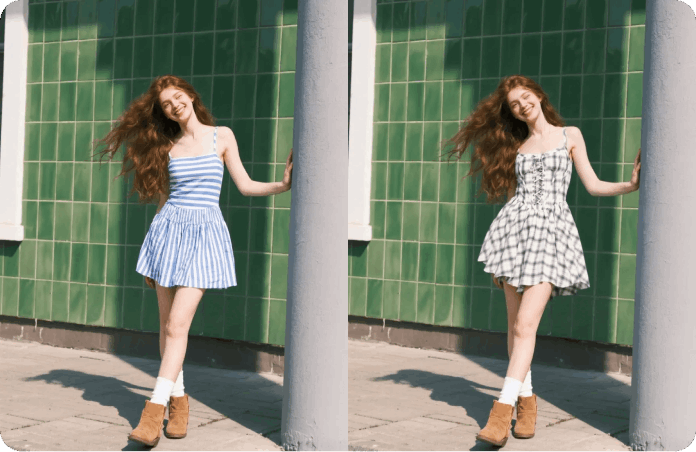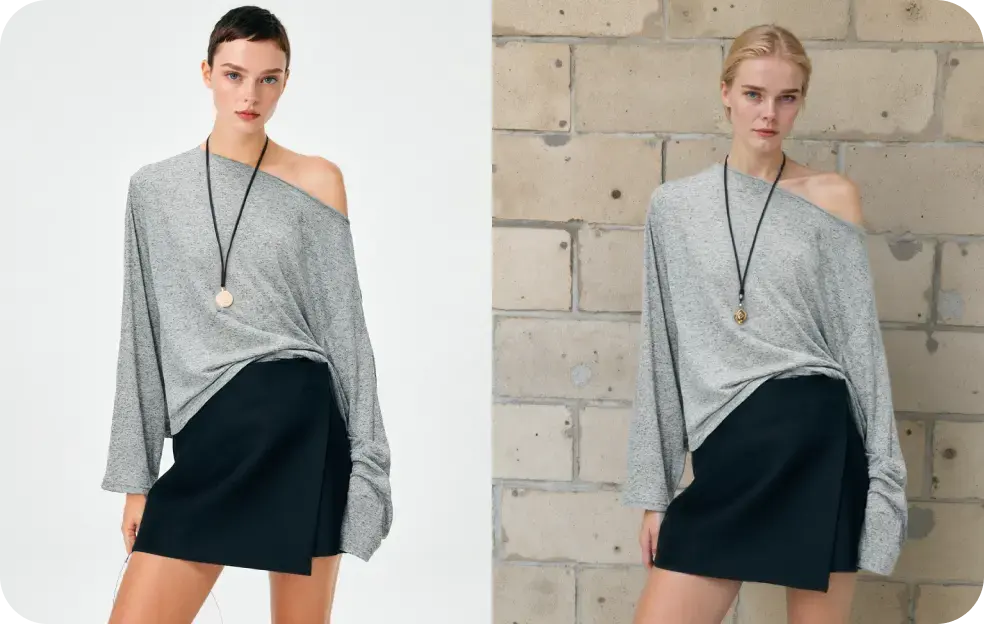Why Manual Photoshoots Are Obsolete for E-Commerce
Creating compelling, on-model product photography is one of the biggest bottlenecks for fashion e-commerce brands. The high costs, logistical complexities, and slow turnaround times of traditional photoshoots limit your ability to scale, innovate, and adapt to rapidly changing market demands. But what if you could generate an entire catalog of stunning, realistic images in a fraction of the time and cost? That’s the strategic advantage offered by an AI outfit changer, empowering brands to achieve unprecedented agility and visual diversity.
As specialists who have extensively tested and implemented AI-driven visual merchandising solutions, we’ve seen this technology transform workflows and unlock new possibilities for brands large and small. Discover the full benefits of AI in visual merchandising. This guide distills our experience into a simple, three-step process for performing a virtual garment try-on that produces images ready for your product pages and marketing campaigns, significantly streamlining your content creation.
Preparing Your Assets: The Foundation for a Perfect Swap
Before you begin, gathering the right digital assets is crucial for achieving a professional result. Based on our analysis of leading platforms, success hinges on the quality of your inputs. You will need:
- A High-Quality Model Photo: This is your canvas. Use a clear, well-lit, front-facing image of a person or mannequin. Higher resolution yields more detailed and realistic final outputs. Learn more about high-resolution imaging for AI.
- A Clean Garment Photo: An image of the clothing item itself, typically shot as a “flat lay” against a plain, neutral background. This allows the AI to accurately isolate the garment’s shape, texture, and color.
- A Professional AI Outfit Changer Tool: Select a platform specifically designed for e-commerce. From our experience, the best tools use precision-fitting technology and are engineered to preserve critical details like fabric texture, natural shadows, and lighting, which separates them from simpler “face swap” style apps. Choosing the right AI outfit changer is paramount for achieving professional, sales-ready results.
Step 1: Upload Your Model and Garment Images
The first step in the process is to provide the AI with its core materials. You’ll begin by uploading your chosen model photo, ideally one that is well-posed and clearly displays the human anatomy. The system is designed to instantly recognize the human anatomy and identify it as the base for the transformation, ensuring accurate placement and realistic draping.
Next, upload the flat-lay image of your clothing item. This is where a professional AI clothing swap tool demonstrates its power. It doesn’t just cut and paste; it analyzes the 2D garment photo and intelligently maps how it should realistically drape, stretch, and fold on the 3D human form in the model photo. This advanced spatial understanding, powered by sophisticated algorithms, works across all product categories, from delicate t-shirts to complex, structured dresses, ensuring a believable fit every time.

Step 2: Generate the Photorealistic On-Model Image
With your assets uploaded, you simply click “Generate.” In moments, the AI performs a complex synthesis that goes far beyond a simple image overlay. It reconstructs the scene to produce a new, coherent, and photorealistic image that looks indistinguishable from a real photoshoot. The key differentiators of a high-quality generation lie in the details, directly impacting customer trust and conversion rates:
- Fabric Texture Integrity: The AI renders the distinct texture of the material, ensuring that denim looks like denim and silk looks like silk in the final image.
- Natural Folds and Shadows: To create a sense of three-dimensionality, the system generates authentic wrinkles, folds, and shadows that correspond to the model’s pose and body contours.
- Accurate Lighting and Reflections: The tool intelligently adjusts for lighting, ensuring the new garment fits seamlessly into the original photo’s environment, even recreating subtle reflections on metallic or glossy surfaces for ultimate realism.
The result is a new photograph where your model appears to be naturally wearing the new outfit. This unparalleled level of realism turns a simple editing task into a powerful sales tool, giving customers the confidence that what they see is what they’ll get, and potentially reducing return rates due to inaccurate product representation.

Step 3: Refine and Optimize for Maximum Impact
While the initial generation is impressive, the real power for marketers lies in refinement and customization. Leading AI platforms provide a suite of features to optimize your images for conversion and brand alignment, transforming raw output into strategic visual merchandising assets. This is where you move from a simple swap to strategic visual merchandising.
Look for tools that allow you to:
- Test High-Engagement Poses: Top-tier platforms offer libraries of 200+ influencer-grade poses. This enables you to A/B test which stances are most effective for your audience without expensive reshoots, allowing for dynamic and data-driven marketing decisions.
- Generate Multi-Angle Views: Showing an outfit from the front, side, and back mimics an immersive in-store experience. This feature directly addresses customer uncertainty, builds trust, and is proven to help increase add-to-cart rates by providing comprehensive product visibility.
- Localize Campaigns with Diverse Models and Scenes: Instantly adapt your marketing for global audiences and diverse demographics. Access to extensive libraries of over 30,000 model assets allows you to match models and backgrounds to different target markets, increasing relevance, connection, and inclusivity in your advertising efforts.
This final step is about transforming a single product photo into a complete set of marketing assets, tailored to specific platforms, audiences, and campaign goals.

Beyond Swapping: Revolutionizing Your Visual Strategy with AI Outfit Changer
In just three steps, you’ve gone from a simple product photo to a fully optimized, sales-driving visual asset. Using an AI outfit changer is more than a novelty; it’s a fundamental and transformative shift in e-commerce strategy. Brands that adopt this innovative technology can create entire product catalogs up to 10 times faster and have the potential to boost conversions by a staggering 90%, all while significantly reducing operational costs.
The power to create professional, diverse, and localized fashion imagery is no longer the exclusive domain of brands with massive budgets. It’s now accessible, instant, and at your fingertips for businesses of all sizes. We highly recommend you try an AI clothing swap tool to witness the transformation yourself—the possibilities for your brand are truly limitless.
Leave a Reply